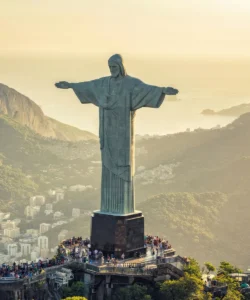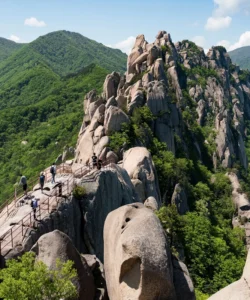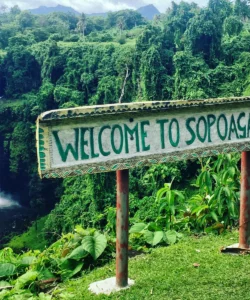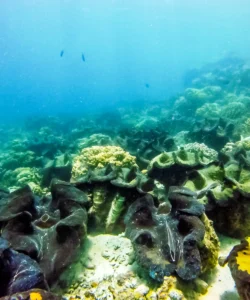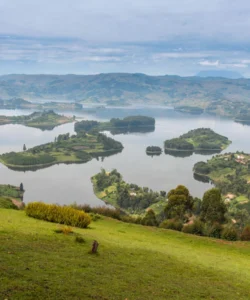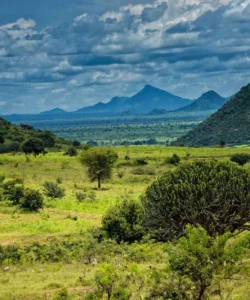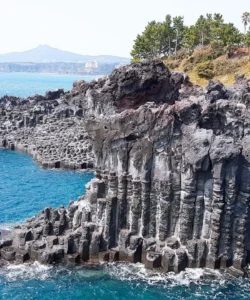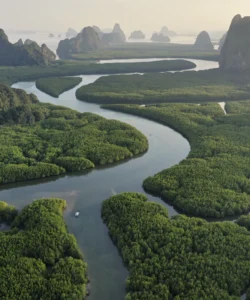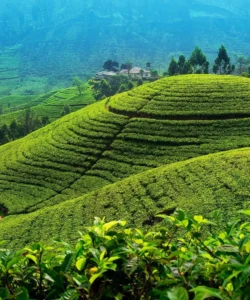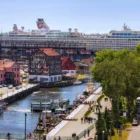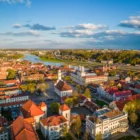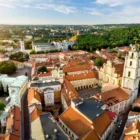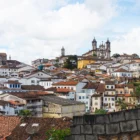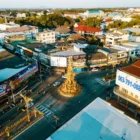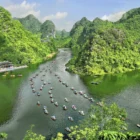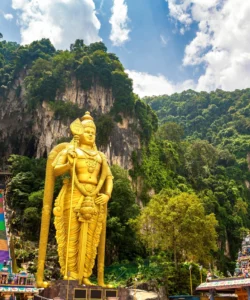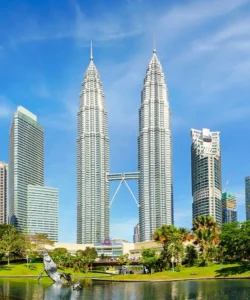Chapada Diamantina National Park (Parque Nacional da Chapada Diamantina) is an awe-inspiring natural wonder located in the heart of the state of Bahia, Brazil. Named for the diamonds once mined there, this vast national park is a geological masterpiece, characterized by towering flat-topped mountains (chapadas), deep canyons, crystal-clear rivers, numerous waterfalls (including some of Brazil’s highest), and a labyrinth of spectacular underground caves and grottoes. It’s a paradise for hikers, cavers, and nature lovers, offering a profound sense of wilderness and a unique blend of semi-arid and lush ecosystems.
Name: Chapada Diamantina National Park (Parque Nacional da Chapada Diamantina). “Chapada” refers to the flat-topped mountains or plateaus, and “Diamantina” for the diamonds once found in the region.
Address: The park is a vast area, covering multiple municipalities in Bahia. The main gateway town and popular base for visitors is Lençóis, a charming colonial mining town. Other access towns include Palmeiras (for Vale do Capão) and Mucugê.
How to get there:
Reaching Chapada Diamantina, involves a very long international journey to South America, followed by domestic travel within Brazil, often via Salvador:
- From Salvador (SSA) to Lençóis (Gateway Town):
- By Bus: This is the most common and economical way. Daily buses depart from Salvador’s main bus station (Terminal Rodoviário de Salvador) to Lençóis. The journey takes approximately 6-7 hours. It’s advisable to book tickets in advance.
- By Shared Van/Private Transfer: Several companies offer direct shared van or private car transfers from Salvador (airport or hotels) to Lençóis, offering more comfort and flexibility. The drive is around 6 hours.
- By Air (Limited): There is a small airport near Lençóis (Lençóis Airport – LEC), with some limited domestic flights from Salvador or other cities. This is the fastest but often more expensive option.
- From Gateway Town into the Park:
- Once in Lençóis (or other base towns), exploration of Chapada Diamantina National Park is primarily done via guided tours (day trips or multi-day treks), which involve 4×4 vehicles for access to trailheads and extensive hiking.
- Local guides are highly recommended, and often mandatory for longer treks, to ensure safety and navigate the park’s vast and sometimes challenging terrain.
Best Time to Visit:
Chapada Diamantina National Park can be visited year-round, but the best time is generally during the dry season, from May/June to October.
- Waterfalls: Waterfalls are still flowing, but river crossings are easier, and hiking trails are less slippery.
- Caves and Blue Pools: The famous underground blue pools (like Poço Encantado and Poço Azul) often have the best light penetration during these months, creating their iconic glowing effect.
- Weather: Temperatures are pleasant for hiking, typically ranging from 20-30°C (68-86°F), with cooler nights.
The rainy season (November to April) brings fuller waterfalls and lush green landscapes, but some trails can be very muddy, and visibility into certain caves might be reduced.
Landscape and Architecture:
Chapada Diamantina National Park’s “architecture” is its spectacular geological formations and the human imprint of its diamond-mining past, integrated with diverse ecosystems:
- Tabletop Mountains (Chapadas): The park is named for its defining feature: vast, high plateaus and flat-topped mountains, often edged by sheer, dramatic cliffs, carved from ancient sandstone and quartzite. Morro do Pai Inácio is an iconic mesa offering breathtaking panoramic views of these “table mountains,” particularly at sunset.
- Deep Canyons and Valleys: Rivers have carved impressive, deep canyons and wide-open valleys through the plateaus, often with lush vegetation at their base. The Vale do Pati (Pati Valley) is a famous multi-day trekking destination, showcasing these dramatic valleys, waterfalls, and secluded communities.
- Spectacular Waterfalls: The park boasts numerous stunning waterfalls, many of which are very high:
- Cachoeira da Fumaça (Smoke Waterfall): Brazil’s second-highest waterfall (and longest single-drop, at 380 meters or 1,247 feet). Its name comes from the phenomenon where water often dissipates into mist before reaching the bottom due to the immense height. It can be viewed from above (long hike) or below (multi-day trek).
- Cachoeira do Buracão: A powerful waterfall plunging into a narrow, circular canyon, offering a dramatic swimming experience.
- Cachoeira do Mosquito: Known for its clear waters and natural pools.
- Crystal-Clear Rivers and Natural Pools: The rivers of Chapada Diamantina are famous for their pristine, often tea-colored (due to tannins from vegetation, not pollution) waters, forming numerous natural swimming pools (poços) and cascades, perfect for swimming and snorkeling.
- Underground Caves and Grottoes: The park is a major speleological site, with a vast network of limestone and quartzite caves, many containing subterranean rivers, underground pools, and impressive rock formations (stalactites, stalagmites).
- Poço Encantado (Enchanted Pool) & Poço Azul (Blue Pool): These are iconic underground caverns with incredibly clear, intensely blue waters. During specific times of the year (April-September), sunlight penetrates openings in the cave ceiling, creating a mesmerizing blue light beam that illuminates the water, making them truly magical.
- Gruta da Lapa Doce: A large limestone cave with impressive stalactites and stalagmites.
- Diverse Ecosystems: The park sits in a transition zone between the Caatinga (semi-arid scrubland) and the Cerrado (savanna), with patches of Atlantic Forest and high-altitude grasslands, resulting in a rich and unique biodiversity.
- Colonial Mining Towns: The gateway town of Lençóis (a former diamond boomtown) is a beautifully preserved colonial town with charming cobblestone streets, colorful houses, and traditional architecture (often Portuguese colonial style), offering a cultural contrast to the natural wilderness. Other towns like Mucugê and Igatu (a ghost town built into stone) also showcase this heritage.
- Archaeological Sites: Some caves and rock shelters contain ancient rock paintings (pictographs), dating back thousands of years, providing a glimpse into the region’s pre-Columbian human history.
What makes it famous:
Chapada Diamantina National Park is famous for:
- Unique Combination of Landscapes: Its unparalleled blend of flat-topped mountains, deep canyons, hundreds of waterfalls, and an extensive network of spectacular caves with glowing blue underground pools is globally unique.
- Cachoeira da Fumaça (“Smoke Waterfall”): One of Brazil’s highest and most famous waterfalls, known for its unique phenomenon where the water often turns to mist before reaching the ground.
- Mystical Blue Underground Pools (Poço Encantado & Poço Azul): These magical, illuminated blue pools are among the most photographed and iconic natural wonders in Brazil.
- Premier Trekking and Hiking Destination: It is considered Brazil’s top destination for trekking and adventure tourism, with trails ranging from easy day hikes to challenging multi-day expeditions (like the Vale do Pati trek, often ranked among the best treks in the world).
- Diamond Mining History: Its name and the charming colonial towns (like Lençóis) are a direct link to its 19th-century diamond mining boom, adding a rich historical and cultural layer to the natural beauty.
- Exceptional Biodiversity: Home to a wide array of endemic flora and fauna, including unique species adapted to its diverse ecosystems.
- Caving and Speleology: A paradise for cavers, boasting the largest number of caves in Brazil.
- Off-the-Beaten-Path Charm: While popular domestically, it offers a more rugged and less crowded experience than some of Brazil’s more internationally famous coastal destinations.
Differences from some other wonders:
Chapada Diamantina National Park distinguishes itself from other national parks, mountainous regions, or cave systems in several key ways:
- “Tabletop” Mountains & Canyons with Blue Caves/Waterfalls: While other places have mountains (e.g., Rwenzori, Seoraksan) or canyons (e.g., Grand Canyon, Taroko Gorge), Chapada Diamantina’s specific blend of flat-topped plateaus, deep canyons, and spectacular, intensely blue underground pools and “flying” waterfalls makes it a unique geological and hydrological marvel.
- Diamond Mining History as a Core Feature: Unlike national parks established purely for natural beauty, Chapada Diamantina’s identity is deeply intertwined with its history as a major diamond-mining region. The preserved colonial towns and the very name “Diamantina” are constant reminders of this past, enriching the visitor experience.
- Combination of Dry and Wet Ecosystems: Its location in a transition zone of multiple biomes (Caatinga, Cerrado, Atlantic Forest) results in an incredibly diverse array of flora and fauna within one park, adapted to conditions ranging from semi-arid to lush rainforest pockets.
- Unique Phenomenon of “Flying” Waterfalls: The Cachoeira da Fumaça’s unique characteristic of water turning to mist before reaching the ground due to its immense height is a very specific and dramatic natural phenomenon.
- Emphasis on Multi-Day Treks to Hidden Gems: While day trips are possible, the Vale do Pati trek and the general ethos of multi-day hiking to discover hidden waterfalls and caves are central to the Chapada experience, offering a deeper immersion than many other parks with more accessible single-point attractions.
- Authentic Colonial Mining Towns as Gateways: The charm and preservation of its colonial mining towns (like Lençóis) provide a unique and historically rich gateway to the natural park, distinguishing it from parks accessed by modern towns or purely functional visitor centers.
In essence, Chapada Diamantina National Park is an extraordinary and multi-faceted wonder, a vast and ancient landscape sculpted by geology and imbued with the spirit of the Brazilian Gold and Diamond Rush, offering an unparalleled journey into a world of breathtaking natural beauty, mystical caves, and profound historical narratives.






















